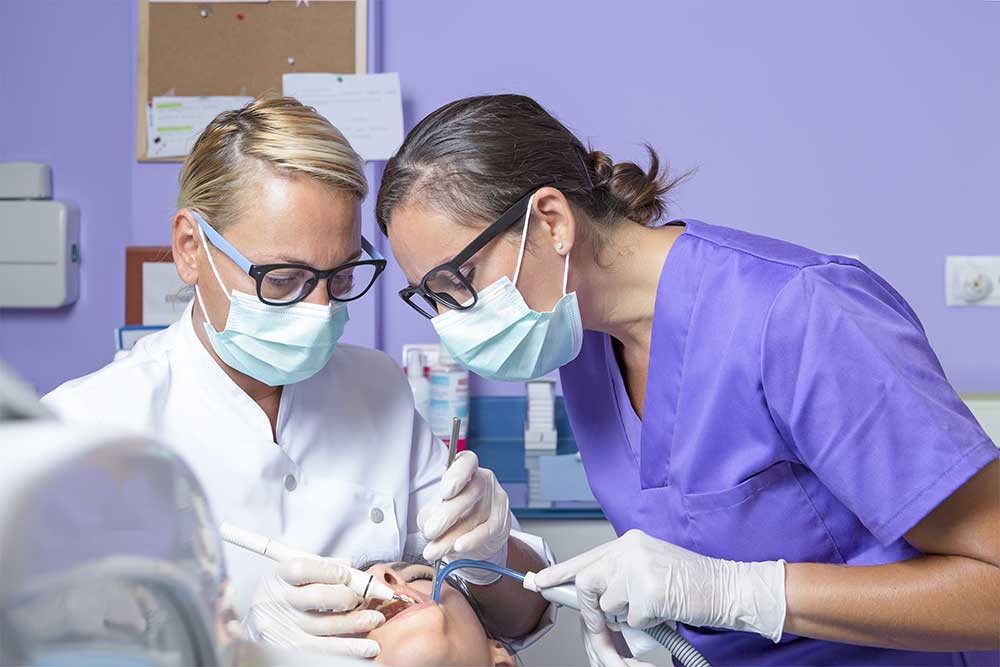Disclaimer: The information on our website is provided for general information purposes only. We make no representations or warranties of any kind, express or implied, about the completeness, accuracy, reliability, suitability or availability with respect to the website or the information contained on our website for any purpose. Any reliance on such information is therefore strictly at your own risk and we are not liable for any damages or losses arising out of or resulting from your reliance on any information contained on our website.
A dental assistant prepares a patient for surgeries, hands tools and equipment to the dentist, operates and monitors equipment, informs patients of diagnoses and treatments, ensures patients are well attended to and cared for, and performs administrative responsibilities. Watch this career video to learn what a dental assistant does.
How to Become a Dental Assistant

There are two ways to become a dental assistant, through formal education or on-the-job experience. Today, most dentists prefer to hire a dental assistant who is trained and nationally certified. Some states (but not all) also require dental assistants to graduate from an accredited dental assistant program and pass a state exam.
According to the Dental Assisting National Board’s (DANB) website over 39 states require or recognize a certification. To search for your state’s requirement go to DANB’s website. The great news is that many community colleges offer short certification programs that span four to six months. These schools may also have an associate’s degree in dental assisting that may include general education courses as well.
A dental assistant may find this position a stepping stone to become a dental hygienist. Dental hygienists make significantly more each year and you only need two years of school to become one. If you haven’t done so yet, be sure to also take our free career test after researching this career field.
Research Dental Assistant Programs
Before enrolling at a college, make sure the American Dental Association accredits the college. All of these programs should include supervised hands on practical experience and bookwork. Research and ensure that the dental assistant program you are applying for is accredited before starting. Some schools list their credentials in addition to the previous years students completion and certification pass rate on the program’s website. If this information is not listed, an admissions advisor can disclose this information as well. High completion and pass rates are a good sign that you have selected a high quality school and are on the road to become a Dental Assistant.
How to Become a Certified Dental Assistant
To take the exam and become nationally recognized by the Dental Assisting National Board (DANB), you must graduate from an accredited school or work for 2 years as a Dental Assistant. The Certified Dental Assistant (CDA) exam is governed and administered by DANB. The exam consists of 3 sub-tests: General chair side, Radiation health and safety, and Infection control. The test is 4 hours long and consists of 320 questions. In 2016, the exam scale was 100-900 and examiners had to score a minimum of 400 to pass. In addition, there are also advanced or specialized exams that one can take to further their skills set. Dental Assistants are eligible to sit for the following:
- Certified Orthodontic Assistant (COA)
- Certified Preventive Functions Dental Assistant (CPFDA)
- Certified Restorative Functions Dental Assistant (CRFDA)
On-the-Job Training
Now, if you live in a state that does not require you to get certified or earn formal training, speak to a dental assistant or dentist to get an idea of what kind of training or experience they expect. Most dental offices that hire dental assistants with no formal education or experience will train you on-the-job. You will gain knowledge and skills in dental terminology, instruments, patient communication, and additional tasks that are required in a dental office.
Job Description of a Dental Assistant
Most dentists that perform intensive dental procedures or surgeries have a dental assistant. A general dentist who doesn’t carry out surgeries may not have a dental assistant. A general dentist may be more inclined to have multiple dental hygienists to assist cleaning patient’s teeth.
A dental assistant may also conduct tests which are not very complicated and do not necessarily require the intervention of a dentist or dental surgeon. In small dental clinics, a dental assistant may be required to schedule appointments and assist the dentist in many tasks apart from the dental procedures, diagnoses, treatment, and patient care. Most dental assistants work closely with dental hygienist and are supervised by the dentist.
Starting as a dental assistant has its pros. You learn dental terminology, chair side etiquette, and dental office procedures. Earning a paycheck is not so bad either. However, some individuals use dental assisting as a career stepping stone to transition into becoming a dental hygienist. Though both positions work in a dental office the vary and have different responsibilities. A dental hygienist has a larger role in contributing to the patient’s treatment rather than office administrative, preparation, and cleaning of equipment.
If you decide to transition to further your career, some schools offer bridge programs that take into consideration your Dental Assistant training and experience. This can also give you an edge over other candidates applying to a Dental Hygienist program. For more information talk to your guidance counselor or an admission representative.
Career Video Transcript
Dental assistants help make dentists more efficient and patients more comfortable. They perform a blend of direct patient care and administrative duties. Dental assistants prepare the dental exam room, sterilizing and setting up equipment. During appointments, dental assistants may take x-rays, hand dentists instruments, keep patients’ mouths dry, and teach patients about proper oral hygiene. On the administrative side, they maintain patient records, schedule appointments, and work with patients on billing and payment.
Essential skills for dental assistants include detail orientation, finger dexterity, listening, and organization. Almost all dental assistants work in dentists’ offices. They wear safety glasses, surgical masks, and gloves, and follow safety procedures to protect themselves and patients. About one-third of dental assistants work part time. Some work evenings or weekends. Requirements to enter the field differ: some states require graduation from an accredited program, and licensure or certification. Other states have no formal educational requirements, and assistants learn their duties on-the-job.
Article Citations
Bureau of Labor Statistics, U.S. Department of Labor, Occupational Outlook Handbook, Dental Assistant.
National Center for O*NET Development. 31-9091.00. O*NET OnLine.
The video is Public Domain from the U. S. Department of Labor, Employment and Training Administration.


